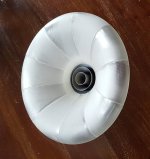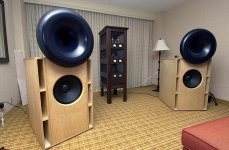It’s not a matter of damaging the product. It’s a matter of leaving toxic material exposed knowing that damage is likely (and often caused by children).
If it were an aluminum or silk or ceramic dome, that would be different.
Please refer to scientific proof of your claim, Beryllium is dangerous as in gas form, not solid state...
Please refer to scientific proof of your claim, Beryllium is dangerous as in gas form, not solid state...
I think you mean airborne, which can happen if a tweeter dome shatters.
It’s not a matter of damaging the product. It’s a matter of leaving toxic material exposed knowing that damage is likely (and often caused by children).
If it were an aluminum or silk or ceramic dome, that would be different.
Edit -not noticed subsequent posts.
I was under the impression that toxicity with beryllium was primarily related to its dust / powder / fumes rather than solid beryllium as such. Granted, if they swallowed the foil it might prove an issue, but I'd be more concerned about them slicing their throats to pieces on sharp edges, which would apply to any other metal dome material. The regular Be dome Satori's are arguably even more exposed as those thin wires don't do much and there's no depth of waveguide. To be sure, I'd rather it had a minor grill or similar, but I don't see a titanic issue as is -if there is any concern on an individual based, the 'do not buy' lights obviously will be flashing. 😉
Last edited:
One should be more concerned burning oil or coal as both element contains Be🙄 I.e. gases again! Educate yourself😀
Well, I've just been burning a bunch of accumulated cardboard delivery boxes since our recycling bins are full, we don't have a compost heap that can take them, and the recycling centres are currently closed due to the Covid-19 lockdown. What I have learned from that exercise is that in future I must check to see if some pillock had shoved a couple of pounds of polystyrene into the boxes before I put them on the bonfire...
Beryllium is brittle but not friable, but I guess you definitely have to be careful if you have someone around who likes to snort small shards of sheet metal.I think you mean airborne, which can happen if a tweeter dome shatters.
https://www.aps.anl.gov/files/APS-sync/centraldocs/policy_procedures/user/docs/APS_1191124.pdf
Any update on the satori waveguide?
Has someone tried it with the monacor or visaton waveguide ?
Regards
Has someone tried it with the monacor or visaton waveguide ?
Regards
It is used in the March Audio Sointuva, which was reviewed by Erin:
https://www.erinsaudiocorner.com/loudspeakers/march_audio_sointuva/
Measures fairly well, with a smooth but narrow dispersion.
https://www.erinsaudiocorner.com/loudspeakers/march_audio_sointuva/
Measures fairly well, with a smooth but narrow dispersion.
Ironic that someone from the company that manufactures that loudspeaker started a thread here bemoaning horn loudspeakers, then went on to design a loudspeaker with a waveguide that beams like a Le’Cleach horn.It is used in the March Audio Sointuva, which was reviewed by Erin:
https://www.erinsaudiocorner.com/loudspeakers/march_audio_sointuva/
Measures fairly well, with a smooth but narrow dispersion.
To be fair, many horn speakers do have the characteristics he complained about in that other thread. To my ears, a dome tweeter in a shallow oblate spheroid waveguide does not sound like a typical conventional compression driver with horn. But ironic, yes.
j.
j.
Yes, that’s a more nuanced point but it’s also a distinction the manufacturer never made in the linked thread; iirc, their objection was to the way a standalone horn/waveguide looked even though (as we see in the ATH thread here) a standalone waveguide that also doesn’t beam would improve the Satori TW29BNWG as used in the above loudspeaker. Just weird to for the manufacturer to walk around with their pants down in public.
Allen, the thread reads exactly as one expects it would with a litany of anti-horn tropes (cuppy, beamy, honky) getting aired in a fashion one could play bingo with. More or less starts with the first post and proceeds from there. After some substantiated pushback the OP modifies their position to have never meant to include waveguides (though they seem unfamiliar with the difference regardless) and then to not actually have included baffle-mounted horns like vintage JBL so we’re left to suppose they just mean standalone L’cleach-looking horns, which, to his credit, do actually beam. Which is actually very funny because as we know, a large standalone, axisymmetrical oblate spheroid waveguide is going to look a lot like any other large standalone axisymmetrical horn, so looks really don’t tell you much as it’s the measured performance that actually makes the difference that we care about.
Last edited:
Last edited:
Not mounted in a baffle
That's obvious but what does it mean in regards to the design, in the context you've mentioned?
Per the work documented on ATH thread here, a standalone waveguide with a mouth terminating with a 180° roundover has smoother directivity than one terminating into a flat baffle.
There’s reasons to accept the slight compromise of mounting a waveguide to a baffle, and/or going rectangular vs axisymmetrical and they mostly have to do with prioritizing ease of manufacturing.
There’s reasons to accept the slight compromise of mounting a waveguide to a baffle, and/or going rectangular vs axisymmetrical and they mostly have to do with prioritizing ease of manufacturing.
I'm not sure you've quite got the concept of termination.Not mounted in a baffle but mounted above or along it. The mouth terminates into “free air” as it were.
- Home
- Loudspeakers
- Multi-Way
- NEW! Satori TW29BNWG-4 Beryllium Dome Tweeter with Waveguide

